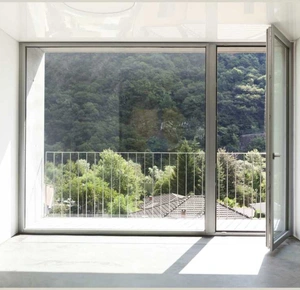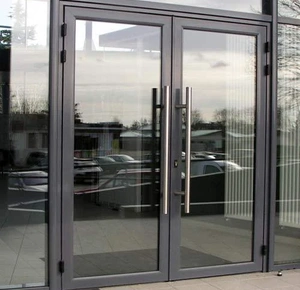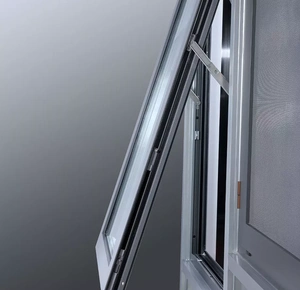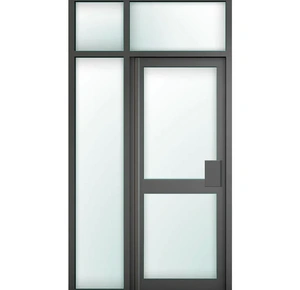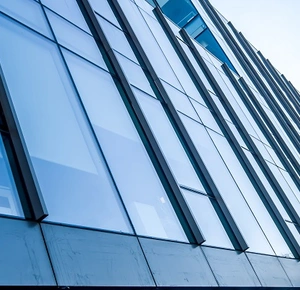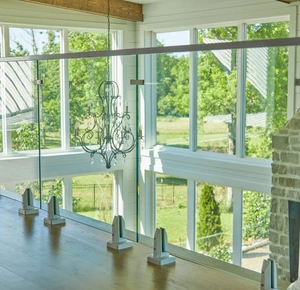Choosing the Right Windows and Doors for Your Building Design
Windows and doors are essential components of any building, contributing to both the functionality and aesthetic appeal of the structure. Whether you are designing a residential home, commercial space, or industrial facility, choosing the right windows and doors can dramatically influence the overall look, energy efficiency, and security of the building.
Given the variety of styles, materials, and performance features available today, it can be challenging to make the right choice. This article provides a comprehensive guide to help you choose the best windows and doors for your building design, ensuring that they not only enhance the architecture but also provide practical benefits such as durability, insulation, and security.
1. Aesthetic Impact and Architectural Style
The aesthetic appeal of your windows and doors is one of the most important factors to consider when selecting them for your building. The right choice can complement your architectural style, whether you’re aiming for a modern, traditional, or industrial look.
How to match windows and doors to your architectural style:
- Modern buildings: Sleek, minimalist designs with aluminium or steel frames are often the best fit for modern architecture. Large windows with slim profiles, sliding doors, and glass-heavy designs are popular for achieving a contemporary, open look.
- Traditional homes: For more classic designs, consider wooden frames or windows with decorative grilles and mouldings. French doors or double-hung windows add timeless charm to traditional homes.
- Industrial spaces: Steel-framed windows and doors with large glass panels are ideal for creating an industrial aesthetic. Pairing metal frames with exposed brick or concrete can add to the rugged, utilitarian feel of the space.
When choosing windows and doors, think about how they will interact with other design elements, such as the roofline, exterior finishes, and overall building layout. Opt for styles and materials that will elevate your building’s overall aesthetic.
2. Functionality and Building Purpose
The function of your building will largely determine the type of windows and doors you should select. Residential homes have different needs compared to commercial offices or industrial buildings.
Windows and doors for different building types:
- Residential buildings: Homes require windows and doors that provide natural light, ventilation, and security. Consider large windows like bay windows or sliding doors that connect indoor and outdoor living spaces. For bedrooms and bathrooms, opt for casement windows or awning windows that offer privacy while still allowing for ventilation.
- Commercial spaces: In offices or retail spaces, windows and doors should balance aesthetics with functionality. Large storefront windows can draw in customers, while sliding or bi-fold doors can help create an open, airy feel. Offices also benefit from energy-efficient windows that minimize glare and reduce energy costs.
- Industrial buildings: Durability and security are paramount in industrial settings. Steel-framed windows and heavy-duty doors made from aluminium or reinforced steel provide strength while maintaining a professional appearance. Windows in industrial buildings should also offer sufficient natural light to reduce reliance on artificial lighting, improving worker comfort and productivity.
Tailor your choice of windows and doors to the specific needs and functions of your building to ensure they perform optimally.
3. Energy Efficiency and Insulation
With rising energy costs and increasing awareness of environmental sustainability, energy efficiency is an essential consideration when choosing windows and doors for any building design. Energy-efficient doors and windows help reduce heating and cooling costs by minimizing heat transfer, making the interior of the building more comfortable throughout the year.
Key energy-efficient features to look for:
- Double or triple glazing: Double-glazed windows consist of two panes of glass with an insulating space of air or gas between them. Triple glazing offers an additional layer of insulation, making it even more effective in colder climates.
- Low-E glass coatings: Low-emissivity (Low-E) glass reflects heat back into the building, reducing energy loss. These coatings are particularly useful for windows that face direct sunlight, helping to keep rooms cooler in summer and warmer in winter.
- Thermal breaks in frames: Materials like aluminium can conduct heat, but modern aluminium frames often include thermal breaks—insulating materials inserted into the frame to prevent heat transfer. This keeps the building more energy-efficient.
By investing in energy-efficient windows and doors, you not only lower your energy bills but also reduce your carbon footprint, contributing to a more sustainable building design.
4. Durability and Maintenance
Windows and doors need to withstand daily wear and tear, along with exposure to the elements. The durability and maintenance requirements of different materials will impact the long-term performance and upkeep of your building.
Materials to consider:
- Aluminium: Aluminium frames are durable, corrosion-resistant, and low-maintenance. They are ideal for both residential and commercial applications, offering a modern aesthetic and long-lasting performance with minimal upkeep. They don’t warp or fade over time, making them suitable for harsh weather conditions.
- Wood: Wooden windows and doors provide a warm, natural look and are great for traditional designs. However, wood requires regular maintenance, such as painting or sealing, to protect it from moisture and pests.
- uPVC: uPVC windows and doors are affordable, energy-efficient, and require little maintenance. However, they may not offer the same longevity or strength as aluminium or wood and can discolour over time.
- Steel: For industrial or high-security applications, steel doors and windows are an excellent choice due to their strength and durability. However, they may require maintenance to prevent rust in areas with high humidity.
Consider the climate, level of exposure, and maintenance requirements when choosing the materials for your windows and doors.
5. Security Features for Safety
Security is a top priority for any building, especially when it comes to windows and doors. The right windows and doors should offer protection against break-ins and provide peace of mind for homeowners and business owners alike.
Security features to look for:
- Multi-point locking systems: Many modern windows and doors come with multi-point locking systems, which lock the door or window at multiple points along the frame, making it harder for intruders to force entry.
- Reinforced glass: Opt for toughened or laminated glass for added security. Toughened glass is much harder to break, while laminated glass consists of two layers of glass with a plastic interlayer that holds the glass together if it’s broken.
- Internal beading: Beading holds the glass in place within the frame. Internal beading is more secure than external beading, as it can’t be easily removed from the outside to release the glass.
Choosing doors and windows with advanced security features ensures that your building is safe and protected from intruders.
6. Ventilation and Airflow
Proper ventilation is essential for maintaining indoor air quality and comfort, especially in homes and offices. The right window and door choices can enhance airflow, improving the overall environment inside the building.
Best window designs for ventilation:
- Casement windows: Hinged at the side, these windows open outward, allowing for maximum airflow. They’re ideal for kitchens, bathrooms, or any room that needs fresh air circulation.
- Sliding windows: Sliding windows are practical for areas with limited space. They don’t obstruct outdoor areas when opened and provide controlled ventilation.
- Tilt and turn windows: These versatile windows can tilt open at the top for ventilation or swing open like a door for maximum airflow.
For doors, sliding or bi-fold doors can help create an open space that allows fresh air to flow through the building, reducing the need for artificial ventilation.
7. Customization and Design Flexibility
Every building has its own unique design requirements, and customization allows you to tailor your windows and doors to meet your specific needs. Whether it’s a bespoke window size, unique door configuration, or a specific finish, customization ensures that your windows and doors fit perfectly into your overall design.
Customization options include:
- Bespoke sizes: Windows and doors can be custom-made to fit non-standard openings or unique architectural features.
- Colour and finish: Powder-coated aluminium frames come in a wide range of colours and finishes, allowing you to match or contrast your building’s exterior and interior design.
- Glass options: You can choose from clear, frosted, tinted, or decorative glass to suit privacy, light control, and aesthetic needs.
Custom windows and doors give you the flexibility to design a space that’s both functional and visually appealing.
Conclusion
Choosing the right windows and doors is an essential part of any building design. By carefully considering factors such as aesthetic appeal, energy efficiency, durability, security, and ventilation, you can find the perfect balance that enhances both the functionality and beauty of your building. Whether you’re working on a home renovation, new commercial project, or industrial development, the right windows and doors can make all the difference in creating a comfortable, secure, and visually stunning environment.
Frequently Question and Answers
How do I choose windows and doors that match my building's architectural style?
Consider your building’s design: modern homes may benefit from sleek aluminium frames and large glass panels, while traditional homes might require wooden frames or decorative designs like French doors or double-hung windows.
What materials should I consider for windows and doors?
Aluminium is durable, low-maintenance, and modern. Wood offers a classic aesthetic but requires regular maintenance. uPVC is affordable and energy-efficient, while steel provides durability and strength for industrial or high-security applications.
How do energy-efficient windows and doors help reduce costs?
Energy-efficient windows with double or triple glazing, Low-E glass, and thermal breaks prevent heat loss and reduce the need for artificial heating or cooling, leading to lower energy bills.
What security features should I look for in windows and doors?
Look for multi-point locking systems, reinforced frames, and toughened or laminated glass for better security. Internal beading also adds extra protection against break-ins.
How can windows and doors improve ventilation?
Windows like casement, tilt-and-turn, or sliding windows are great for controlling airflow. Doors like sliding or bi-fold designs can also improve ventilation by opening wide and connecting indoor and outdoor spaces.
Are custom windows and doors necessary for my building?
Customization is beneficial for buildings with unique architectural features. Custom windows and doors allow for tailored sizes, finishes, and glass options, ensuring they fit perfectly into your design.
